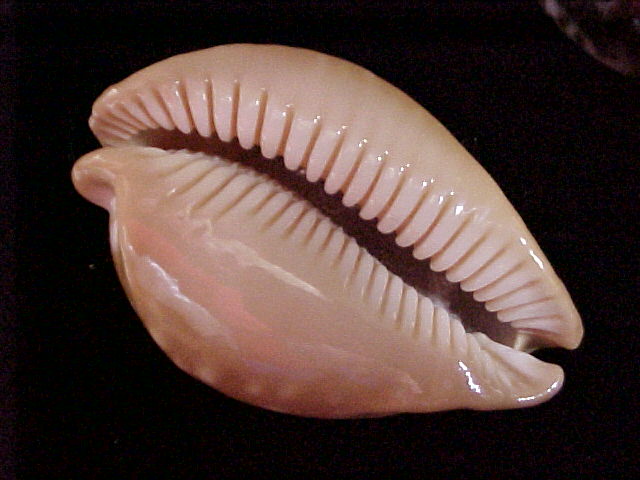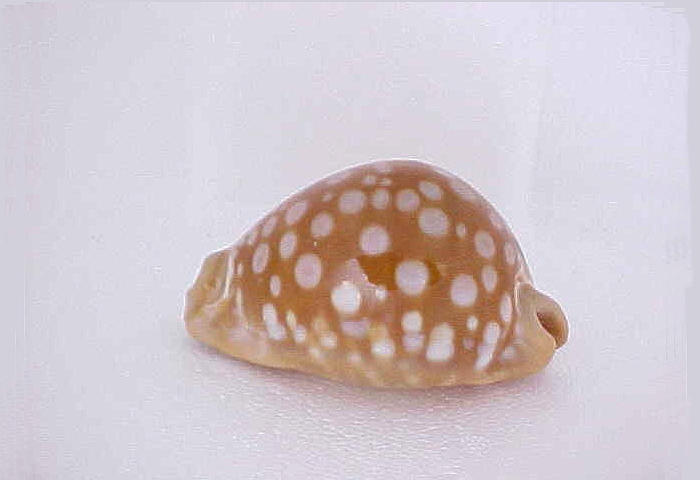|
|||||||||||||||||||
|
|||||||||||||||||||
|
|
|
(The
once upon a time legendarily rare but still pricey White Toothed Cowrie)
|

|
 |
|
Class: Gastropoda Subclass: Mesogastropoda Family: Cypraeidae Species: Cypreaea leucodon Broderip, 1828 English Names: White Toothed Cowrie Localities:
Image: Taken by Ian Holden on a Sony Mavica MVC - F73 |
|
The leucodon cowrie is one of several Cyp-critters than one can pay over $1000 USD for a decent specimen of, without really trying. Up until the early 1990s, it was fabulously, almost legendarily rare, with few specimens making it to private collections. Then, as with most "rarities", its preferred dwelling places were discovered: in cracks, crannies and caves 30 to 70+ meters (160 to over 220 feet) deep, off the outer fringes of reefs - deeper than most divers like to venture, and very hazardous to reach, due to strong currents and nasty waters outside the reef's protective shelter: small wonder it was so hard to obtain before the age of deep-water SCUBA!!! There are still a few hype-prone toruist sites on the "web" which call it "one of the rarest shells in the world", which while true in say, the 1970s, is most certainly not the case today. It's teeth are one of its most salient and interesting features - it is simply NOT confusable with any other cowrie, although i've seen fakes created by carving hump-backed cowries (C. mauritiana L.) and artistically painting them: the infamous Philippine Shell Doctors can make such immitations look quite convincing, and not a few shellers of ALL levels of experience have been fooled by their handiwork by times!! It;s commercial history is an interesting one: after its "Coming out" party in the early to mid 1990s, the price dropped out of the sky, in a manner similar to that of Conus gloriamaris in the late 1980s. By the year 2000, good specimens were being sold on -gasp !! - eBay for $300. However, unlike its Cone counterpart, it has not continuted to become less dear: rather, it seems that a combination of rampant hoarding by a few of the major Philippine shell "middlemem", and misdirected government regulation of some of the more famous "rare" marine species (meaning hard to obtain: very few marine species are in any danger of becoming extinct any time soon, althogh some local populations of shallow water species have been polluted out of existance or nearly collected to death for the tourist or mollusc-meat trade..), have conspired to again raise the price of this once-legendary and still highly prized calcareous exoskeleton, which every Cyp-specialty-collector wishes to have represted in their showcase. |
|
The Cypraea family (which is currently divided into a number of genera (35 or so), with more consistancy and widespread acceptance than with the Conidae - although it was a long, hard-fought battle!!) has long been a favorite of collectors, for several reasons: 1) They are shiny. Like crows, species of the primate genus Homo (like us....) are for some reason attracted to shiny, pretty objects, 2) They have attractive patterns and colors, and many species are surprisingly variable - in other words they are almost all quite aesthetically pleasing - in the vernacular, they are "pretty". 'nuff said....3) They are mostly of medium size so far as shells go: one can hold them in one's hand and examine them all at once, without using a hand-lens or having to use 2 hands to hold one (with the exeption of very large C. cervus, which can reach the size of a soccer ball. On the other hand, a very few species such as irrorata Gray and minoridens Melvill, are fully adult in the 7 to 10mm range), 4) They are mostly a pleasing oval shape, with a flat bottom: they display well, and 5) Unlike most families of Mollusc, if one has enough raw purchasing power, it is possible to obtain a complete set of them - which has always been a collector's dream!! There are about 220 species and an amazing number of subspecies, and named forms and varieties: when something is as popular and often expensive as the Cyp clan, taxonomic "splitters" seemingly can't resist the temptation to name every variation they can claim to be reliably differentiatable from similar variants - dealers make more money selling more forms, collectors get to add more named goodies to their assemblages, taxonomists get to make a name for themselves: it's a win-win-win game!! Subspecies and ecologically-related variations in my world-view deserve valid names. However, assigning a varietal moniker to the albino form of a species or a color morph, is a bit "beyond the pale" if you ask me (although as a shell-seller, i never turn down a "forma" name when one is offered.....) |
|
Despite their relative paucity of diversity (many molluscan families such as Muricidae and the infamous Turridae, have radiated into thousands of species), cowries have been incredibly successful in almost all tropical marine habitats - from the shallow water turtle-grass flats where C. tigris L. grows by the millions, to the deep-water caves and crevases where "rarities" such as leucodon and broderipi Sowerby (South Africa - similar deal to leucodon, except they are still extrordinarily difficult to find) lurk. Species such as moneta and annulus (both not surprisingly described by Linnaeus!) are so abundant in many parts of the Indian and Pacific that they were used as money. Indeed, the considerable fortunes of the East Indian Trading company, which propelled the tiny nation of the Netherlands briefly into prominance amongst European colonial powers - until they were shouldered aside by the British bulldog of the seas - were to a large extent acquired by skillfullly trading cowries from one locality, for spices and other goodies more suitable to Old World tastes and purses!! There is a story - likely apocrophal (ie, a lie or rumor someone started for various reasons...) - of an island in the Indian Ocean where 100,000 C. moneta would suffice to purchase a wife - but it took 200,000 of the little yellow cowries to purchase a bull. ANYWAY, all cowries are vegetarians: most make a living by using their long, relatively "primiative", undifferentiated radulae to scrape algae off of rocks, corals and other substrates. Most have free-swimming larval forms capable of being carried long distances before settling down elsewhere: this is a major contributor for both the very wide distribution of many species ("Indo-Pacific"), and their lack of species diversity. Cowries are not all that speedy, and are the favorite prey of many cone species and other carnivores of the ocean. Their main defences are their thick, very hard shells, and their narrow, "toothed" aperature, which makes it difficult for predators to come or reach in after them. |
|
Return
to Man and Mollusc Home Page
|
Return
to Present
"Mollusc of the Moment" |
Go to Previous
"Mollusc of the Moment" |
|
Visit
Schooner Specimen Shells
by Ross Mayhew creator of The Mollusc of the Moment Articles |
||